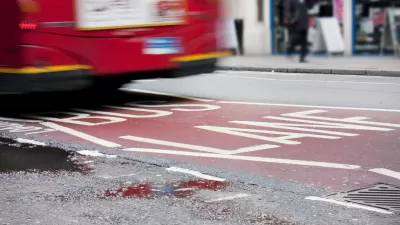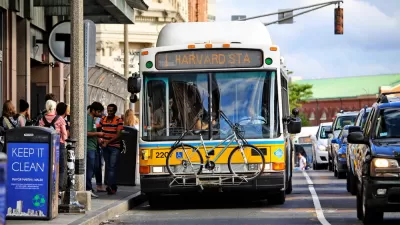Stephen Lee Davis investigates a campaign by Baton Rouge community groups to revive its bus service as it teetered on the brink of collapse.
Roughly a year ago, Baton Rouge's Capital Area Transit System (CATS) was faced with a fiscal crisis that threatened to shut it down altogether. But thanks to a coalition "of churches, faith-based groups, social workers, and university students and groups" dubbed Together Baton Rouge, citizens passed a ballot measure to raise taxes not only to keep the system alive, but to double its funding and give it a major facelift.
At the peak of CATS' financial woes, the mayor appointed a blue ribbon commission to see what could be done. Said commission chair Rev. Raymond Jetson: "Before there can be a robust transit system, before you can do novel things like light rail between Baton Rouge and New Orleans, and before you can have street cars from downtown to LSU, you have to have a backbone to the system. And that backbone is a quality bus system."
In part, the coalition built buy-in by promising specific improvements to the system that citizens could sink their teeth into. These promises were presented at every single public meeting:
- Decreased average wait times for buses from 75 minutes to 15 minutes.
- Eight new express and limited stop lines, serving the airport, universities, mall and other areas.
- GPS tracking on the entire fleet, with exact arrival times accessible on cellphones.
- New shelters, benches and signage at bus stops.
- Expanded service to high-demand areas and increased routes, from 19 to 37.
- Three new transfer centers operating in a grid system to replace the outdated route system that leads all buses back to Florida Boulevard.
- A foundation for Bus Rapid Transit, a system in which buses get their own right-of-way lanes.
Between Together BR, the blue ribbon commission, and the non-profit Center for Planning Excellence, community leaders were able to pursue extensive outreach, holding 120 outreach sessions in the four months leading up to the vote.
A reorganization of CATS' governance structure is waiting to pass through the state legislature, but the passage of the measure represents a major victory for transit and political mobilization in the area.
FULL STORY: Saving a transit system and turning the tide for the future of a mid-sized city

Planetizen Federal Action Tracker
A weekly monitor of how Trump’s orders and actions are impacting planners and planning in America.

Maui's Vacation Rental Debate Turns Ugly
Verbal attacks, misinformation campaigns and fistfights plague a high-stakes debate to convert thousands of vacation rentals into long-term housing.

Restaurant Patios Were a Pandemic Win — Why Were They so Hard to Keep?
Social distancing requirements and changes in travel patterns prompted cities to pilot new uses for street and sidewalk space. Then it got complicated.

In California Battle of Housing vs. Environment, Housing Just Won
A new state law significantly limits the power of CEQA, an environmental review law that served as a powerful tool for blocking new development.

Boulder Eliminates Parking Minimums Citywide
Officials estimate the cost of building a single underground parking space at up to $100,000.

Orange County, Florida Adopts Largest US “Sprawl Repair” Code
The ‘Orange Code’ seeks to rectify decades of sprawl-inducing, car-oriented development.
Urban Design for Planners 1: Software Tools
This six-course series explores essential urban design concepts using open source software and equips planners with the tools they need to participate fully in the urban design process.
Planning for Universal Design
Learn the tools for implementing Universal Design in planning regulations.
Heyer Gruel & Associates PA
JM Goldson LLC
Custer County Colorado
City of Camden Redevelopment Agency
City of Astoria
Transportation Research & Education Center (TREC) at Portland State University
Jefferson Parish Government
Camden Redevelopment Agency
City of Claremont





























